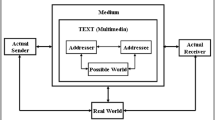Abstract
Multimedia document authoring is a multifaceted activity, and authoring tools tend to concentrate on a restricted set of the activities involved in the creation of a multimedia artifact. In particular, a distinction may be drawn between the design and the implementation of a multimedia artifact.
This paper presents a comparison of three different authoring paradigms, based on the common case study of a simple interactive animation. We present details of its implementation using the three different authoring tools, MCF, Fran and SMIL 2.0, and we discuss the conclusions that may be drawn from our comparison of the three approaches.
Similar content being viewed by others
References
C. Alexander, S. Ishikawa, and M. Silverstein, A Pattern Language: Towns, Buildings, Construction, Oxford University Press, 1977.
J.F. Allen, “Maintaining knowledge about temporal intervals,” Communications of the ACM, Vol. 26, No. 11, pp. 832–843, 1983.
3. M.C. Buchanan and P.T. Zellweger, “Automatic temporal mechanisms,” in Proc. Multimedia’93, ACM Press, 1993, pp. 341–350.
D.C.A. Bulterman and L. Hardman, “Multimedia authoring tools: State of the art and research challenges,” in Computer Science Today: Recent Trends and Developments, volume 1000 of Lecture Notes in Computer Science, Jan van Leeuwen, (Ed.), Springer-Verlag, 1995, pp. 575–591.
H. Cameron, P. King, and S. Thompson, “Modelling reactive multimedia: Events and behaviours,” Multimedia Tools and Applications, Vol. 19, No. 1, pp. 53–77, 2003.
A. Courtney, “Frappe: Functional reactive programming in Java,” in Practical Aspects of Declarative Languages ‘01. LNCS 1955, I.V. Ramakrishnan, (Ed.), Springer-Verlag, 2001. Available at http://www.haskell.org.
C. Elliott, “Composing reactive animations,” Dr Dobb’s Journal, July 1998. Expanded version with animated GIFs: http://research.microsoft.com/conal/fran/tutorial.htm.
C. Elliott and P. Hudak, “Functional reactive animation,” in Proceedings of the 1997 ACM SIGPLAN International Conference on Functional Programming (ICFP97), ACM Press: Amsterdam, The Netherlands, June 1997, pp. 263–273, (Also SIGPLAN Notices, Vol. 32, No. 8, pp. 196–203, 1997).
C. Elliott, G. Schechter, R. Yeung, and S. Abi-Ezzi, “TBAG: A high level framework for interactive, animated 3D graphics applications,” in Proceedings of SIGGRAPH ‘94, ACM Press: Orlando, Florida, 1994, pp. 421–434.
E. Gamma, R. Helm, R. Johnson, and J. Vlissides, “Design patterns: Elements of reusable object-oriented software,” Professional Computing Series, Addison-Wesley: Reading, Massachusetts, 1994.
L. Hardman, G. van Rossum, and D.C.A. Bulterman, “Structured multimedia authoring,” in ACM Multimedia ‘93, Anaheim, California, Aug. 1–6, 1993, pp. 283–289.
J. Hughes and S. Peyton Jones, (Ed.), Report on the Programming Language Haskell 98, http://www.haskell.org
B.B. Kristensen and K. Osterbye, “Roles: Conceptual abstraction theory and practical language issues,” Theory and Practice of Object Systems, Vol. 2, No. 3, pp. 143–160, 1996.
T.D.C. Little and A. Ghafoor, “Interval-based conceptual models for time-dependent multimedia data,” IEEE Transactions on Knowledge and Data Engineering (Special issue on Multimedia Information Systems), Vol. 5, No. 4, pp. 551–563, 1993.
M. Nabil, A.H.H. Ngu, and J. Shepherd, “Modelling moving objects in multimedia databases,” in Database Systems for Advanced Applications ‘97, Proceedings of the Fifth International Conference on Database Systems for Advanced Applications (DASFAA), volume 6 of Advanced Database Research and Development Series, R.W. Topor and K. Tanaka, (Ed.), World Scientific: Melbourne, Australia, April 1–4, 1997, pp. 67–76.
J. Nanard, M. Nanard, and P. King, “Media construction formalism: Specifying abstractions for multimedia scenario design,” The New Review of Hypermedia and Multimedia, Special Issue on Time in Multimedia, Vol. 6, pp. 47–87, 2000.
J. Nanard, M. Nanard, and P. King, “Media construction patterns: Abstraction and reuse in multimedia application specifications,” in Proceedings of Multimedia Computing and Networking 2001, San Jose, California, SPIE, 2001, pp. 123–134
J. Peterson, C. Elliott, and G.S. Ling, “Fran users’ manual,” Available from http://www.haskell.org
V. Quint, C. Roisin, and I. Vatton, “A structured authoring environment for the World-Wide Web,” Computer Networks and ISDN Systems, Vol. 27, No. 6, pp. 831–840, 1995.
D. Riehle, “Composite design patterns,” in Proceedings of the 1997 Conference on Object-Oriented Programming Systems, Languages and Applications (OOPSLA ‘97), ACM Press: Atlanta, Georgia, Oct. 5–9, 1997, pp. 218–228.
P. Schmitz, “Multimedia meets computer graphics in SMIL2.0: A time model for the Web,” in em WWW 2002, Honolulu, Hawaii, 2002, pp. 45–53.
S. Thompson, Haskell: The Craft of Functional Programming, 2nd edn., Addison Wesley, 1999, (ISBN 0-201-34275-8).
S. Thompson, “A functional reactive animation of a lift using Fran,” Journal of Functional Programming, Vol. 10, No. 3, pp. 245–268, 2000.
M. Vazirgiannis, Y. Theodoridis, and T. Sellis, “Spatio-temporal composition and indexing for large multimedia applications,” Multimedia Systems, Vol. 6, No. 4, pp. 284–298, 1998.
T. Wahl and K. Rothermel, “Representing time in multimedia systems,” in International Conference on Multimedia Computing and Systems, pp. 538–543, 1994.
World Wide Web Consortium (W3C), Synchronized Multimedia Integration Language (SMIL 2.0) Specification, August 2001. (Available at http://www.w3.org/AudioVideo).
Yale Haskell group and the Center for Computational Vision and Control, Frob: Functional robotics. http://haskell.cs.yale.edu/frob/ 1998–1999.
Author information
Authors and Affiliations
Corresponding author
Additional information
Simon Thompson is grateful to the British Council for its funding of travel in support of the work reported here.
Supported by an individual research grant from NSERC. This author’s research was performed, in part, at LIRMM, Montpellier, France.
Supported by an individual research grant from NSERC.
Rights and permissions
About this article
Cite this article
Thompson, S., King, P. & Cameron, H. Modelling Reactive Multimedia: Design and Authoring. Multimed Tools Appl 27, 23–52 (2005). https://doi.org/10.1007/s11042-005-2713-9
Issue Date:
DOI: https://doi.org/10.1007/s11042-005-2713-9




